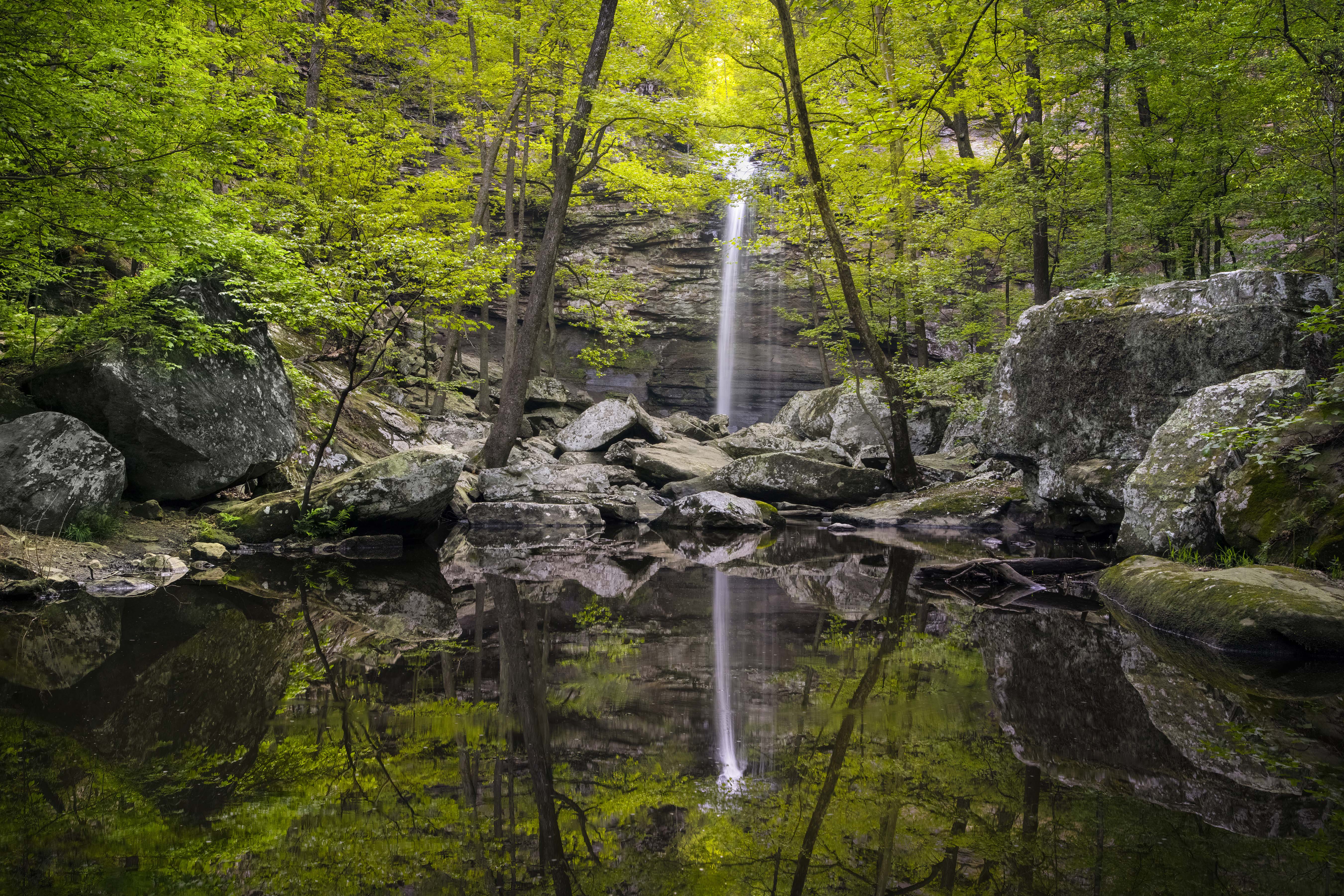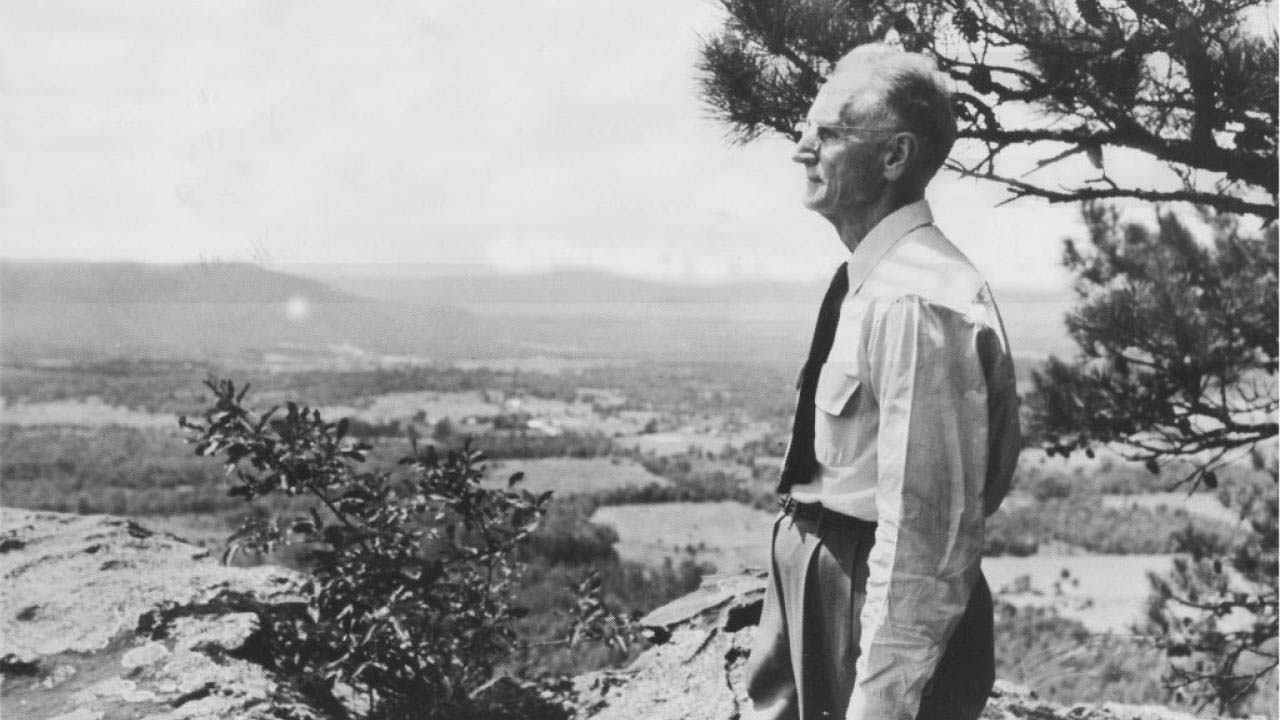The Father of Arkansas State Parks
January 30 - February 5, 2023
By Jay edwards
The oldest state park in Arkansas turns 100 this year. But the inspiration for what is Petit Jean came 16 years earlier, in 1907, when a physician employed by the Fort Smith Lumber Company had an idea while listening to men argue on the best way to remove the trees from the seven hollows area.
“While listening to the discussion,” Thomas William (T.W.) Hardison would later write, “the idea occurred to me that the trees might as well be left to live out their lifespan unmolested by axe and saw, and the area converted into a park.”
The lumbermen who were trying to come up with ideas to move the trees were part of the Fowler Mill in Perry County, which was owned by the Fort Smith company. The mill would close in 1909. By then Dr. Hardison had married Julia Hutto and they had their only child, a boy they called Son. Hardison called Julia “Mother,” and she called him “Daddy.” They eventually built and settled in a small stone house on top of Petit Jean.
The diaries of Dr. Hardison are available to read online through the Arkansas State archives. They begin in 1923 and run through 1957, the year he died. His early entries were on calendar pages from a company called Reed and Carnuck out of Jersey City, New Jersey, with a motto, “Pioneers in Glandular Therapy.”
His first entry, on January 1, 1923, reads, “Wrote 1500 words of ‘The Phantom of Frenchman’s Point.’”
In trying to make ends meet over the years, Hardison had marketed his skill for writing through country doctor tales that appeared in such publications as Ladies Home Journal and Country Gentlemen.
On January 2 he wrote that he had dinner with a Mr. Ellison and that he fixed Mrs. Strait’s Ford car.
On March 17 he wrote, “Called this morning to see Charlie Hale’s family where there are thirteen with measles — twelve in bed in one room.”
On March 5th he tells of discussing some house plans with George Crowder, who recommended a stone house.
On the 28th Hardison caught the flu, and his next few entries tells how sick he was.
He didn’t write again until May 5th, when he said he had left the mountain and headed to Turkey Run State Park in Indiana for a conference on state parks.
On May 7, now at the conference, he met with Mr. Mather and other delegates. Dr. Hardison explained his plan to the other park delegates. When he had finished, he wrote, “Mr. Mather placed a star on a map for Petit Jean State Park.”
According to the National Park Service website, Stephen T. Mather was a wealthy, gregarious businessman, who came to Washington from Chicago in January 1915 as special assistant to Secretary of the Interior Franklin K. Lane for national park concerns. His vigorous efforts to build public and political support for the parks helped persuade Congress to create the National Park Service in 1916. Appointed the first NPS director in May 1917, he continued to promote park access, development, and use and contributed generously to the parks from his personal fortune. During his tenure the service’s domain expanded eastward with the addition of Shenandoah, Great Smoky Mountains, and Mammoth Cave national parks. Periodically disabled by manic-depression, Mather left office in January 1929 after suffering a stroke and died a year later.
Dr. Hardison had first approached Mather with the idea to designate Petit Jean as a national park. But after visiting the area Mather recommended Hardison spend his efforts for the development of a number of state parks, beginning with Petit Jean.
The conference in Indiana ended but before heading back to the mountain, Hardison spent the day in Lake Forest, Illinois, outside Chicago, at the home of Laurance H. Armour, the nephew of the meatpacking dynasty founder, Philip Danforth Armour. He wrote, “I like Mr. Armour very much, and his kennel manager, Robert Law. Wonderful dogs.”
On May 13 he was back home in Conway where he “found Mother and Son well.”
On June 21 the reason for his side trip to see Mr. Armour became clear when he wrote that he had received a shepherd dog named Wiesa von der Festaburg from Mr. Armour. The dog had been bred to another elite purebred whose long name I can’t make out. “The mating proved unsuccessful,” Hardison wrote.
No more entries until October 8 when we learn that he has taken Wiesa to compete at the state fair in Little Rock. Wiesa didn’t disappoint, winning best in her class and “unofficially” the best dog in the show. “The Arkansas Democrat came out to photograph her.”
Hardison’s last entry in 1923 was on October 12 when he wrote, “Shipped Wiesa to Lake Forest, Illinois for breeding, where she was bred October 20th to Ajax von Luzenburg.”
One of the many perks of winning Best in Show, I guess.
I skipped ahead past the next 33 years of Dr. Hardison’s diaries to 1957, the year he died. Since Petit Jean had been designated as the first state park, 13 more were added by the end of 1957. And since that time another 38 have joined the list.
Hardison began his 1957 diary by reporting on the weather on New Year’s Day, which was cloudy and 38 degrees. On January 2 he wrote, “Mother went to town with Reba and Jim, 9:30 AM, to get her hair done. Home at 12:30.
Over the next few months Dr. Hardison wrote mainly about seeing his patients and his own slowly declining health. On January 21, he and Julia watched Ike’s inauguration and parade on television.
On the 23rd he decided he wanted to go be examined, believing his ailments were due to a urinary tract infection.
The next day he learned of the malignancy in his prostate. He didn’t share his emotions but wrote the diagnosis down like a doctor telling a patient.
On February 22 he wrote that he and Mother “watched Muggs for the last time on the Today Show.” This was a chimp named J. Fred Muggs who appeared for five years with Dave Garroway and supposedly saved the show from being cancelled from bad ratings.
Dr. Hardison’s last entry came on March 27, when he said that Dr. Cecil Dickerson of Conway had died. “Cecil and I had been friends since 1902.”
The next day in the diary was another entry in different handwriting. “Mr. Brand took Daddy to St. Anthony’s Hospital in Morrilton. Daddy is very weak,” wrote Julia.
On April 1, she wrote, “I telephoned Son at nine o’clock this evening to tell him of Daddy’s serious condition. He said he would fly home at once. He and Mary left San Francisco at midnight. Bud Edwards phoned at 2 o’clock (our time) that they would arrive in L.R. at 8:35 next morning.”
That last sentence made me do a double take because my father’s name was Bud. I guess it could have been a different Bud Edwards but since they are all from Conway, I feel like this is dad. I was born a little over six weeks later. My father’s relationship with Son is a mystery to me that I hope I can learn more about.
Julia’s saddest post came six days later — “Daddy died at 11 P.M. It seems so hard to bear but the suffering is over. For that I am thankful. Such a good and useful man. The world needs more like him.”
Yes we do Mrs. Hardison. Yes we do.
The rest of Dr. Hardison’s diaries can be found at digitalheritage.arkansas.gov. Other sources used in this piece were arkansas.com, Encyclopedia of Arkansas and the National Park Service.
Photo Captions:
1. Cedar Falls at Petit Jean State Park
2. The man who envisioned Petit Jean as a park




